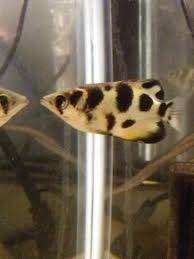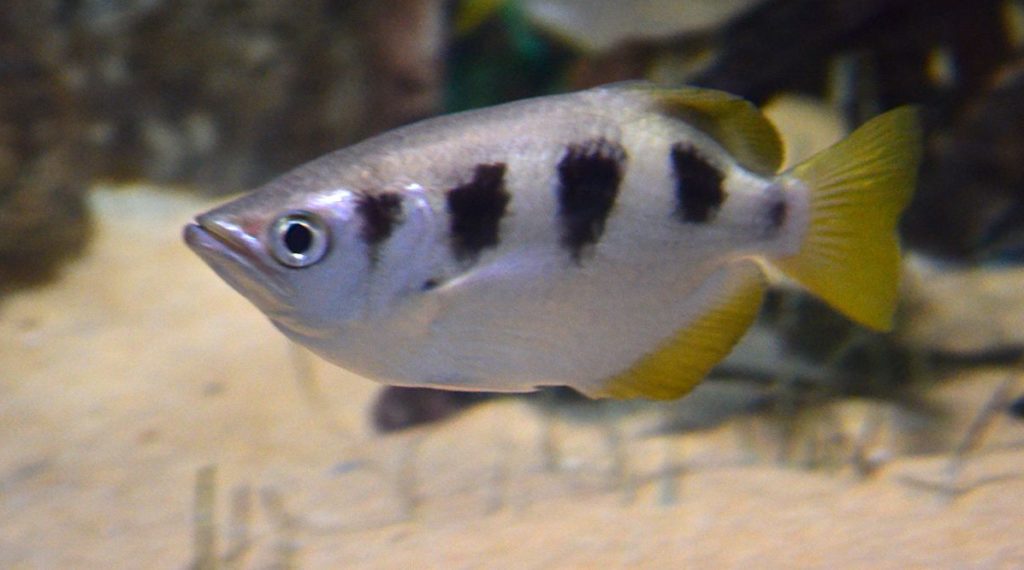The banded Archer Fish (Toxotes jaculatrix) is a percifom fish belonging to the Toxotes genus. This interesting fish commonly lives in tropical Asia and Australia, in locations such as Papua, New Guinea and northern Australia.
Table Of Content
- 1 Taxonomy
- 2 Learning about the Toxotes Genus
- 3 Banded Archer Fish’ Main Characteristics
- 4 Habitat and Distribution
- 5 What do banded Archer Fish Eat?
- 6 The Banded Archer Fish’ Shot
- 7 Banded Archer Fish’ Reproduction
- 8 The Archer fish as Pets
- 9 Other Archer fish Species
- 10 Smallscale archerfish (Toxotes microlepis)
Taxonomy
Kingdom: Animalia Phylum: Chordata Class: Actinopterygii Order: Perciforms Family: Toxotidae Genus: Toxotes
Learning about the Toxotes Genus
Fish of this genus live naturally in fresh water and saltwater from Malaysia and India to Australia. Their most outstanding feature is given by their hunting technique consisting of spitting water to topple insects resting on the surface and make them rush into the water.
The archer fish have a sort of groove on the roof of their mouth. Their tongue is quite thin and free in the anterior part, but thick and muscular in the posterior, with a fleshy bulge towards the middle area. When pressing the tongue and bulge against the oral ceiling, the groove becomes a narrow tube. The free and fine end of the tongue acts as propellant.
Banded Archer Fish’ Main Characteristics
The banded archerfish (Toxotes jaculatrix) is a brackish water perciform fish of the archerfish genus Toxotes. Their name refers to Sagittarius the archer, due to their uncommon method to capture prey. 
This fish is silvery white or yellowish with 4 to 6 black transverse bars on the back. Its ventral area is uniform white and the fins are translucent white. Their big eyes are positioned for binocular vision while their head is slightly shorter than the body, with a distinctively pointed snout.
The young specimens have some irregular yellow patches, mainly in the upper part between the bands. Their body is flattened and elongated, with a pointed head. Some specimens have a gorgeous golden color, but they are not easy to find. We invite you to read our article the anatomy of fish to learn more about such a topic.
Length
The archer fish can reach up to 30 centimeters in length, although its average size is 20 centimeters.
Let’s meet them
Habitat and Distribution
The banded Archer Fish is a saltwater species commonly found in tropical Asia and Australia. They are found in localities such as Papua, New Guinea and in northern Australia. They live mainly in salty mangroves where they spend their time crossing the reefs looking for food although they also move to rivers and streams. In general, adults are lonelier and can swim alone towards coral reefs.
What do banded Archer Fish Eat?
These little stalkers are mainly carnivorous. In their natural habitat they feed on insects, spiders, small fishes and crustaceans that hunt on the surface of the water spitting a stream of water on them. In aquariums they usually prefer living invertebrates, small live insects and small fish.
The archer fish has developed the ability to shoot his food by forcing a stream of water through a groove in the roof of his mouth. This jet of water is strong enough to hit insects and spiders from low branches in the water, where they are quickly devoured.
They seem to have a sixth sense that allows them to guess the exact place where the food will land, going there to capture it before the current of the water drags them.
The Banded Archer Fish’ Shot
Their mouth is adapted to spit water jets from a distance. It usually lifts its tongue against the roof of its mouth forming a tube while its operculum closes quickly, pressurizing the water along the tube.
Most archers are able to spit in a range of 150 centimeters, although some larger specimens reach ranges of up to 2 to 3 meters. When a prey is knocked down, the fish begins to move towards the place where it will land within 100 milliseconds and can reach it within 50 millimeters of where the water hits the prey.
One study found that banded Archer Fish could be trained to hit mobile targets with an accuracy rate of more than 50%. According to this study, the ability to hit mobile targets is a complex learned behavior and can be learned from other members of the school.The study concluded that the fish could shoot more accurately after observing other members of the shooting school.
The banded Archer Fish is able of hitting the targets with a high degree of precision, despite the refraction of the light in the water air interface, it is believed that they are able to reach this level of precision by positioning their bodies to shoot from directly under the intended target.
However, later studies have found that the banded archer fish are able to achieve great accuracy even at angles, suggesting that they are somehow able to compensate for refraction. This may also suggest that they are able of three-dimensional tasks.
Mastery of physics
A study published in the magazine «Current Biology» ensures that these fish are actually «snipers» much more skilled than anyone could have imagined. Banded archer fish use water as a tool, and is the first animal, that is known, capable of changing the hydrodynamic properties of a jet according to the occasion.
Their body is designed to go unnoticed. From above, the point of view of its prey, its narrow shape makes it almost imperceptible in the water, to which its black and white stripes contribute, which serve as camouflage under the vegetation of the mangrove, where it lives.
In these forests that grow in the water, there are not as many preys available as it might seem, so the aim is, more than a quality, a need.
«It is important to be able to hit the prey hard from a wide range of distances,» explains Stefan Schuster, from the University of Bayreuth, Germany, one of the two authors of the study.
Up to one and a half meters away can reach their powerful jet. And it is capable of firing up to seven times in a row. He achieves this by forming a tube with his tongue and the roof of his mouth through which the water comes out at great speed when his gills are slammed shut.
The key for the shot to be accurate is to form a large drop of water at the end of the jet that hits the dam hard, as was known long ago thanks to slow motion. But it was not known exactly how he got it. And to find out, Schuster and Peggy Gerullis, the two authors of the study, trained the fish to reach targets located at a height of 20 to 60 centimeters in precise location. To extract its secret, they observed the different aspects of the production and propagation of the jet in the different shots.
Thus, they found out that the necessary time for the drop of water to form at the end of the jet is not fixed. Actually, the fish makes adjustments to make sure that a good drop of water forms just before the impact. Surprisingly, these archery fish achieve this with something as «simple» as modulating the opening of the mouth.
Near-human qualities
These adjustments necessary for the fish to hit its targets with a wide range of distances are only comparable to the «exclusively human» capacity for the launch, the researchers point out. «One of the last strongholds of human singularity is our ability to forcefully throw stones or spears at distant targets,» explains Schuster.
«This is really an impressive capacity and requires, among many other aspects, a fascinating control of the movements. It is believed that this ability has prompted our brain to grow to accommodate a greater number of neurons that allow such precision. The same line of reasoning could also be applied to the archer fish. »
let’s watch and learn…..
Banded Archer Fish’ Reproduction
Banded Archer fish reach adulthood in around 1 to 2 years. It is believed that they swim from their brackish water habitats to coral reefs and coral rocks to spawn. The reproduction is caused by the rains that end the tropical dry periods. The female lays about 20,000-150,000 eggs that are about 0.4 mm (0.016 inches) in diameter.
The Archer fish as Pets
The archer fish are a very suitable for community aquariums as long as they are kept with large fish so they do not feed on them. Their breeding has spread throughout the world and they They have a life expectancy of ten years that they enjoy peacefully although they are quite active.
They need, at least, 100 liters of water to survive in good conditions. The water temperature should be between 23-28ºC, with a gH> 15º and a pH of 7-8. Small insects or fry are good options for their diet. Although it is not too demanding with maintenance conditions, its breeding is considered difficult.
Common Behavior
Archer fish have a peaceful behavior with specimens of their own species, but aggressive with small fish. They often hunt in teams of several fishes shooting at a single target. Once the target insect has been hit, the fastest and closest fish wins the prize. The fish that knocks down the prey is not always the one that ends with the food, so the archer fish prefer to jump out of the water to catch the prey before another fish.
Fish Tank
Banded archer fish need excellent water conditions, and their environment must be monitored regularly and water tested weekly. The minimum aquarium size for this fish is 55 gallons and the higher the tank the better. There should also be open space above the waterline, as they like to jump.
An aquarium 45 centimeters deep, filled two thirds with water is approximately the minimum for adult specimens. This provides several inches above the water level so that these fish can spit out the morsels of food stuck in the glass.
A good filtration is a must-have to ensure the archer fish’s health, since they live mainly in brackish mangroves, so their tank’s water should also be brackish. The moderate lighting is the one suggested for them as well as plants that stand out above the water replicating their natural environment. Be sure to provide hiding places like floating wood and different twisted roots and the substrate should consist of fine sand or gravel.
Diseases
Archer fish when young are freshwater fish, but for long-term care it is recommended that they move to brackish water. Some pet stores sometimes do not indicate this information to their customers due to employee failures or they simply assume that people know it and if they are not placed in a saline environment this will lead to many different diseases.
The archer fish usually does not get sick if kept in an adequate aquarium, although it must be taken into account that any object that enters the aquarium can cause disease bacteria.
Be very careful and be sure to properly clean each object and animal to enter or quarantine anything that you add to your aquarium so as not to upset the balance of the ecosystem. The archer fish is very resistant once it is established in a tank.
A good thing about the archer fish is that, due to its resistance, an outbreak of disease can often be limited to only one or a few specimens if known at an early stage.
.here we go…
Other Archer fish Species
Let’s meet the whole family
Seven-spot archerfish or largescale archerfish (Toxotes chatareus)
This specimen reaches sizes of up to 40 cm in freedom but will not generally exceed 25 cm in captivity. However it is a large fish for freshwater aquariums. They live in the middle and lower courses of the river basins of northern Australia being also also distributed in Southeast Asia (India and Sri Lanka) and New Guinea.
The Toxotes chatareus can be located in fresh waters of both rivers and lakes and in brackish areas of estuaries, or mangroves. Their favorite areas are those with aerial coverage, which helps them get most of their insects-based diets. The rest of the diet is completed with small fish, aquatic insects and crustaceans.
Smallscale archerfish (Toxotes microlepis)
This archer fish has an inverted and laterally compressed triangle shape and deeply curved belly. Pointed V-shaped snout in which the lower jaw protrudes and protruding mouth. The Smallscale archerfish has the largest eyes within the genus toxotes in a backward position, (almost at the end of the head,) which adapt to a binocular vision and which give them the ability to see a prey that is on top. Their single dorsal fin has 4-5 spines. Both this and the anal fin are very delayed with respect to the body.
Body Color:
The Smallscale archerfish has a body of bright silver color, almost white. It has two to five drop-like spots that go through its body on the back. In addition, they have a pale yellow color on the tip of all the fins excepting the anal one which is white or silver with yellow tips and their scales have a blue flash
Size:
Between 15 and 16cms of maximum size in aquariums. In the wild they can double this size.
Habitat and Distribution
Smallscale archerfish are salt water fish commonly found in the mouths of the great rivers of Asia (Mekong and Chao Phraya rivers and their river basins), in the peninsula of Malacca; in Sumatra and Borneo and in places like Papua, New Guinea or in northern Australia. They have adapted to life in the waters of deltas and estuaries with dense terrestrial vegetation, although it can also inhabit areas of open sea related to reefs, always near the coast. Therefore, it is a fish that migrates from salt water to fresh water, but not for breeding as other species.
let’s have a final look of them









